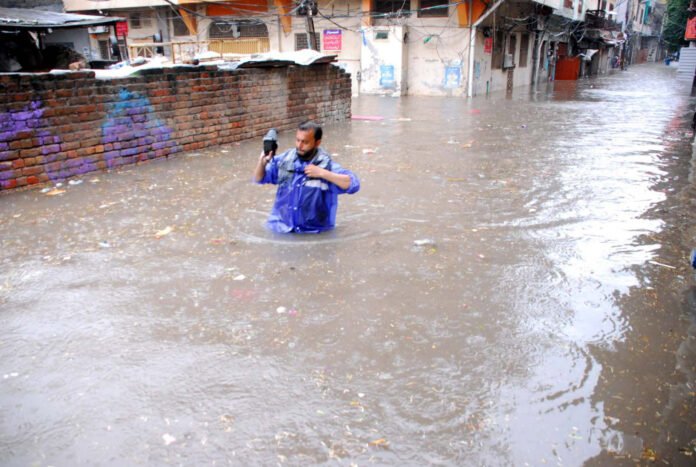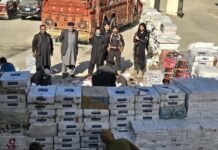Torrential monsoon rains have brought life to a standstill across Punjab, causing devastating floods, widespread infrastructure damage, and tragic loss of life. In Rawalpindi alone, over 230 mm of rain was recorded within 15 hours, pushing water levels in key drains and rivers to dangerous levels. Sirens wailed across low-lying neighborhoods as Nala Lai overflowed, and the Pakistan Army was deployed to assist in rescue and relief operations.
Across Punjab, 63 people have lost their lives and over 290 have been injured within just 24 hours, as confirmed by the Provincial Disaster Management Authority (PDMA). From collapsed dams and flooded roads to submerged homes and disrupted communications, the disaster has triggered an all-out emergency response from federal and provincial authorities.
Rawalpindi: A City Drenched and Disrupted
The twin cities of Rawalpindi and Islamabad bore the brunt of the monsoon deluge. The Water and Sanitation Agency (WASA) reported that the water level in Nala Lai had reached a critical 21 feet at Katarian and 20 feet at Gowalmandi — the danger mark that triggers flood alerts. Sirens were activated, and mosques broadcast urgent evacuation messages.
Traffic was severely affected across major roads such as Murree Road, Committee Chowk Underpass, Jamia Masjid Road, and Iqbal Road. The Deputy Commissioner of Rawalpindi declared a one-day public holiday and urged residents to stay indoors unless absolutely necessary.
Due to the overflowing drains and poor pre-rain preparation, areas such as Bahria Town Phase 8, Tench Bhata, New Chakra, and Jan Colony saw rainwater entering homes. In many cases, residents had to call for rescue assistance, and in Ladian village on Chakri Road, a helicopter was dispatched to rescue a family trapped on their rooftop.
Chakwal’s Catastrophe: Dam Collapse and a Town Submerged
Perhaps the most shocking development came from Chakwal, where a cloudburst led to a record-breaking 423 mm of rain within 10 hours. The sudden downpour caused the Panwal Dam to breach, inundating the Bhitta Khisht area and leading to the collapse of eight dams and fifteen bridges.
The sacred pond at Shri Katas Raj Temple also flooded, raising concerns about the preservation of the historic religious site. More than 35 families trapped by rising waters were evacuated to safety. The district administration declared an emergency and sought assistance from the Pakistan Army to help control the worsening situation.
Province-Wide Emergency and Government Response
Chief Minister Punjab, Maryam Nawaz, swiftly declared a rain emergency across affected regions including Rawalpindi, Chakwal, and Jhelum. All departments — including the police, rescue services, and municipal bodies — were placed on high alert. Over 15,000 rescue personnel and 800 boats have been deployed province-wide.
Speaking to the media, Maryam Nawaz emphasized the urgency of public cooperation:
“The people must follow safety instructions and cooperate with field officers. We are committed to safeguarding lives and restoring normalcy.”
At the federal level, Prime Minister Shahbaz Sharif convened an emergency meeting to assess the damage and response strategy. The Prime Minister directed the Chief Commissioner of Rawalpindi and the Managing Director of WASA to submit an immediate report.
Islamabad and Other Cities Also Affected
Islamabad saw continuous rainfall, with Saidpur village recording 132 mm, Golra 164 mm, and Bokra (I-12) 185 mm. In Rawalpindi, areas such as Chaklala, Pirodhai, and Katarian saw rainfall above 200 mm.
The rising water level in Rawal Dam — currently at 1,747 feet, just five feet below its maximum capacity — has prompted close monitoring by Islamabad’s district administration.
Elsewhere, cities like Mandi Bahauddin, Wahali Zir, and Chowasidan Shah reported 210 mm, 351 mm, and 330 mm of rain, respectively, transforming roads into water channels and forcing people to abandon vehicles and homes.
The Wider Impact Across Punjab
Rescue operations are underway across the province. In Jhelum, districts like Dhok Badar, Chak Muhammad, and Bhampar saw coordinated rescue efforts by Rescue 1122 and the Pakistan Army, who evacuated dozens of people using boats.
In the Attock district, officials visited Shahpur Dam in Fateh Jang as water was released through the spillway to manage overflow. Citizens were warned to avoid low-lying areas.
According to PDMA’s spokesperson, alerts have been issued across multiple districts, including Lahore, Faisalabad, Gujranwala, DG Khan, Bahawalpur, Sargodha, and Murree. Many of these areas are already experiencing flooding, with the risk of landslides in hilly regions such as Galiyat and Murree.
Forecast: More Rain and More Trouble Ahead
The National Disaster Management Authority (NDMA) has warned of continued heavy rainfall in the next 24 to 48 hours. The organization has expressed concern over urban flooding, overflowing rivers, and increased landslide risk in northern areas.
District emergency operations centers have been activated throughout Punjab, with control rooms monitoring river levels, drainage systems, and affected populations in real time.
According to the NDMA, vulnerable areas in the coming hours include:
- Urban Centers: Lahore, Rawalpindi, Faisalabad, and Sialkot
- Flood-Prone Districts: Jhelum, Chakwal, Khushab, Attock
- Landslide Zones: Murree, Galiyat, and adjoining hilly regions
A Call for Preparedness and Long-Term Planning
The ongoing disaster has once again highlighted Pakistan’s vulnerability to monsoon flooding and the glaring gaps in urban drainage, dam maintenance, and emergency preparedness. The failure to clean critical drains such as Nala Lai and negligence in dam reinforcement have contributed to avoidable damages.
Urban planners, environmental experts, and civil society groups are now urging the government to prioritize climate resilience infrastructure, better forecasting systems, and public awareness campaigns.



